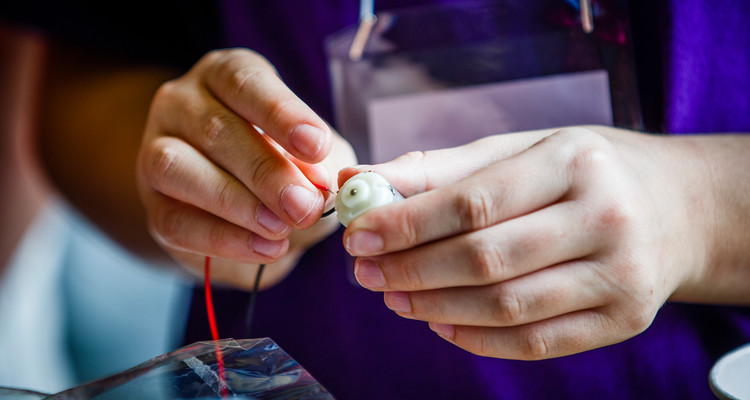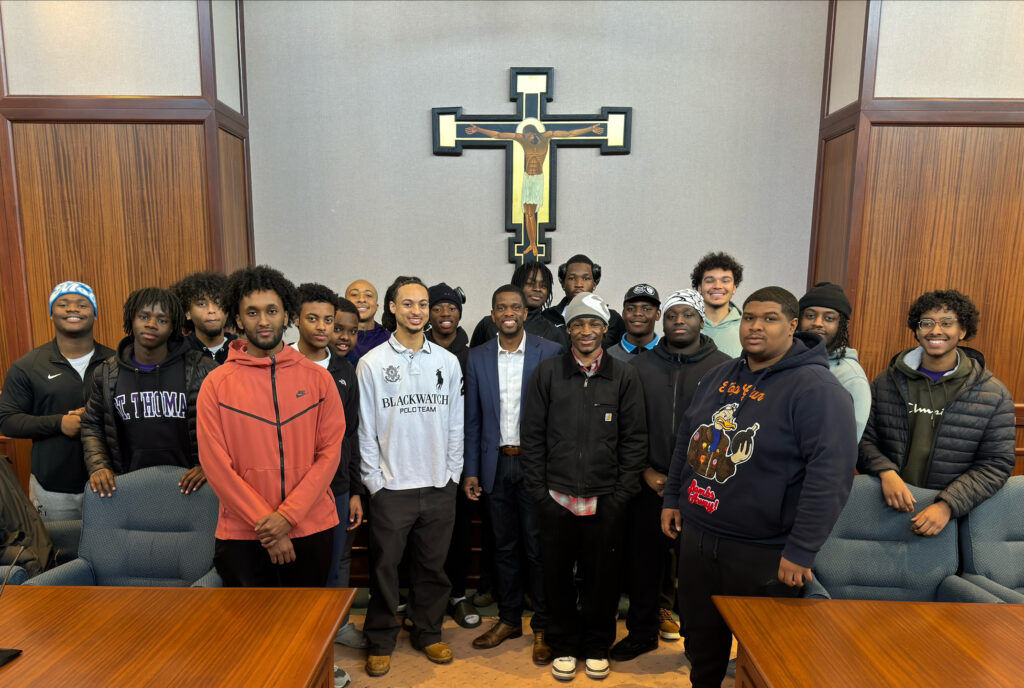"Programs like ours are trying to...show if girls are interested in math and science, they should pursue those."
Before Alison Haugh ’16 came to St. Thomas she didn’t really know what an engineer even did. Now a fourth grade teacher at Glacier Hills Elementary in Eagan, Haugh realized as a Tommie how interested she was in engineering.
“There’s a good chance I would have gone that route for a career if I would have known more,” she said. “I didn’t want that same thing to happen to any other young girls.”
It makes sense, then, that Haugh did everything she could to prevent that by helping lead St. Thomas’ Science, Technology and Engineering Preview Summer (STEPS) camp, an annual, week-long series of one-day camps for sixth and eighth grade girls. Campers go through one-day, hands-on, collaborative workshops with classmates and St. Thomas engineering faculty and students, all with the goals of exposing them to potential engineering careers, college life and igniting an interest in science, technology, engineering and mathematics (STEM).
The program has been in place since 2000 at St. Thomas, and addresses the continuing discrepancy in female representation within engineering: According to NSF data, women earned just 19.3 percent of bachelor’s degrees in engineering in 2013, and make up just 15 percent of the engineering workforce.
“There’s no difference in middle school between ability levels in math between girls and boys, but the stigma and the perception is huge. Programs like ours are trying to fix that and show that, if girls are interested in math and science, they should pursue those. And if they’re good at them they should continue to do it and not succumb to the idea that boys are supposed to be doing math and engineering, not girls. That’s super important,” said senior Jenna Laleman, an education major who took over coordinating duties from Haugh and helped run the camps in 2016 and 2017. “Research shows (women) have this ability level. If you can get more diversity, different ideas, backgrounds, interests in a field, it’s only going to help that field grow. That’s true in engineering, but in any facet of life, really.”
This year’s 92 campers worked in teams on creating prosthetic hands out of straws, string and tape, a model that not only shows the accessibility of engineering with any materials, but the collaboration and creativity that’s inherent to engineering.
“You hear engineering and think math and science, writing equations and figuring them out. The way it was presented in (my engineering education) class and the way we present it with STEPS is so fun,” Laleman said. “To see that engineering is cool and fun for students to experience is huge. It expands their minds about what engineering is and makes it accessible to classroom teachers.”
Professor Deb Besser – an active proponent of encouraging girls to pursue STEM education in many arenas – runs the camp and brought in both Haugh and Laleman. While most of their research from STEPS is qualitative, she said, the value has been evident for years.

Engineering professor Deb Besser teaches visiting students during an Explore Engineering session June 6, 2017, in the Facilities and Design Center in St. Paul.
“It’s the self-fulfilling thing where more people are getting excited about getting into engineering, they can see how maybe they have different perspectives and different ways of doing things, and we’re definitely creating a culture where they can do what they want if they’re interested,” she said.
Laleman wrote a research paper last summer coming out of her STEPS experience and – in interviewing and surveying girls throughout the week – saw a marked change in their attitudes and awareness of what engineering can be.
“One of the big questions before and after was, ‘What do you think an engineer is?’” Laleman said. “We looked at how, beforehand, students said, ‘An engineer is someone who uses science, technology, engineering and math.’ That was their answer, that STEM acronym. Afterward it was more, ‘Someone who creatively solves problem with a team.’ They had a much more defined idea, so it was cool to see those changes.”
There has also been a marked change in Haugh and Laleman’s perceptions, too.
“It had a great impact on me. It was incredibly empowering to not only learn so much about something I didn’t know, but to see all the participants show up year after year, the flood of applications, of people who wanted to get involved,” Haugh said. “It was really empowering and spoke volumes to me that there is great interest in coming to camps for engineering for kids of all genders. That shifted my ideas of gender roles in society in general.”
Both Haugh and Laleman said their ideas about how engineering can fit into their role as educators changed as well.
“I realize now how transformative the design thinking process can be in a classroom. Those basic steps of asking questions about things, brainstorm, plan your ideas, then create and test. That kind of process is how students can think about anything. That’s a big thing I’ll take away into my classroom … for any subject matter. It’s great to see how interdisciplinary it is,” Laleman said. “Kids are natural engineers. It’s a lot about tinkering and figuring things out, having a question about something and trying to figure out a solution. You walk into a kindergarten classroom and that’s what kids are doing all the time, building with blocks or just figuring out how life works. If we can channel some of those more creative aspects early on, that’s really powerful.”
“We should be having fun and our students should be having fun as we work through things with them. … Students learn best when they’re doing hands-on activities, when we’re engaging them not only intellectually but physically,” Haugh added. “Helping students develop a mindset where they have wonder and have initiative to make a change. Our job as educators is to provide them the tools to guide them there, not necessarily to tell them what to think.”
Laleman said she hopes to continue the tradition of passing on student leadership for STEPS to another education major peer; Besser said it was very valuable having both Haugh and Laleman’s perspectives to help keep the program fresh.
“We want to increase the students’ self-efficacy and we want to increase their interest in engineering by exposing it to them. We’re able to accomplish both of those things if we’re trying new things every year and we’re getting a feel for what the temperature is out there and what are folks really interested in now,” Besser said. “(Haugh and Laleman) have really done a great job going out (to engineering faculty), feeling what’s out there and bringing back new activities that the others would probably not develop at that scale.”
Visit the STEPS website for more information about the program and the engineering department.







